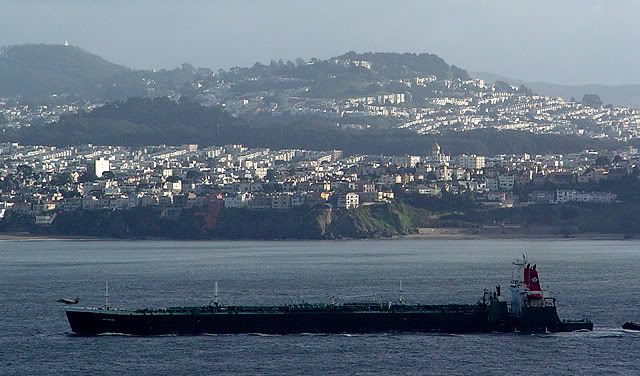Air Tanker In Yaolin, this was the spectacular sight that caught the eyes of locals as they looked across the waters of Hiyan Bay. Beginning at 8:30 in the morning, they witnessed an LF-8 Skyhawk fighter taking off from and landing on the deck of a large oil tanker. The Skyhawk made a total of six takeoffs and landings, the thump of landing on the tanker's deck can be heard from shore. What in the world was going on?

What they have just seen, was the first operational testing of the Navy's ECV-1, it's first operational carrier ever. This unique vessel is fully capable of carrying and launching a complement of 30 LF-8 Skyhawks, all in an effort by the LN to develop a naval air strike and power projection capability.
The ECV-1 was conceived four years ago, when HOLA begin to draw up plans for an aircraft carrier to strengthen the expanding navy. Unable to get its hands on one abroad, the project managers were force to come out with it's own design. Work was thwart by lack of expertise and cost factors. It took the prodigy of senior engineer Lin Halin to overcome these crippling drawbacks. His solution was simple: modify a conventional oil tanker into a working carrier platform. Oil tankers were a good choice, with their large size and practical design. However, finding a oil tanker large enough to carry a launch deck was a problem. The country's shipbuilding industry was still expanding and the Navy's shipyards were occupied by other projects.
It was then that project researchers found out about a half-built VLCC tanker sitting in the dry docks of Star Coast Ltd. The
Prosperity, as it was originally register as, was a double hull supertanker order by
Sui Petro, a private oil distributor in Loyan. With the increasing demand for oil in Loyan, Sui Petrol wanted an up-sized vessel to carry Terran crude oil to it's refinery in Na Sui. If finish, it would had been able to carry up to 300,000 tons of crude oil in its enormous tanks. When the Sui Petro went bankrupt three months later, Star Coast was left with large hulk of metal and no one to pay for the half-finish ship hull. Measuring at 327 metres long and 52 metres wide, it met the size requirement for a carrier deck. the LN immediate placed an offer, and worked with Star Coast and fifteen other private contractors to modify the design.
Work began a year later. The filling tanks were cut and seal at half their height, and a wide second deck created between the main deck and the stunted tank compartments. The midsection tanks will contain the fuel for the ECV-1's engines.The second deck forms the hangar for the carrier's planes and was subdivided into crewquarters and rooms.The main deck was widen by 7.3 m at the starboard, the extension supported by diagonal steel struts. The main deck is cover in Asphelt, a plastic substitute for road asphalt, to provide a good runway surface for the planes. An indigenous steam catapult and landing arrestor system is fitted. A electronics package is also integrated into the ship, allowing the ship to have full military telemetry and coordination. Work was completed two months ago, and the ship was registered as the
SLS ECV-1 Fortune. It's construction is reported to have cost 220 million international dollars.
In yesterday's carrier flight, the flight deck, launching catapult, and arrestor cable were tested and found satisfactory. Before this, tests were conducted on static systems installed on land. These essential takeoff and landing systems were refined in these ground tests to allow for the real test on board the ECV-1. Test pilots also honed their technique during the ground test, skills that were needed to fly off safely from an aircraft carrier. For the most part, the Skyhawk took off and landed successfully through the test; except for a jam in the arrestor's gearing which luckily did no damage. LAA pilots reported no complications either with their takeoff and landing procedures.
The next step for the LN will be to do a moving test. Yesterday's test was done with the ECV-1 anchor and stationary in the water. Takeoff and landing on a moving platform will pose a step up in difficulty for the test pilots. Project managers are currently running computer simulations in preparations for this second test, to minimize unforeseen issues that might arise. The LN admits that the test will still carry risks for pilots and test crew. If the testing is successful, the ECV-1 will enter operational combat service with the Loyanese Navy, despite its limited capabilities (lower speed and capacity, unconventional flight deck,..etc.) compare to conventional aircraft carriers operated by other nations. It will serve as a operational testbed for Loyanese carrier program until newer designs become available.
ECV-1 Fortune
Length: 327 m
Breadth: 52 m (waterline)
Draught: 25 m
Displacement: 88,500 tons fully loaded
Propulsion: 2x steam turbines
Speed: 15 knots max
Aircraft Complement: 30 modified LF-8 Skyhawks, to be transfer from the LAA